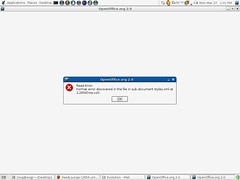Over the past several days, I’ve been a bit heads down on a project for one of our newer clients helping to create some marketing materials. One of the pieces of that project is a written deliverable, and the first draft of this deliverable was due today. Despite having a rather heavy tracel and work schedule last week, I managed to wrestle the document into a state in which I could at least get some feedback/input from my colleague.
Taking advantage of the time zone differential between Denver and London, James processed the document in the morning his time, and when I opened my laptop first thing this morning I was delighted to see a reply from him with a revised and updated attachment (I would have used Writely, but I wrote most of it on planes over the weekend). Because RedMonk’s a cross-platform shop (I’m on Linux, Cote’s on OS X, and James is on Windows XP), the Open Document Format makes the most sense for us – for offline pubs, anyway. This deliverable was no exception, and the version I’d created was ODF and that’s what he returned to me.
Unfortunately, his version of Star Office / Open Office somehow corrupted the file on save. The edited version that he sent me this morning would not open, returning me the message pictured. When I first pinged him, I was holding out hope that it was simply a transmission error in email, or some other error on my side, but he quickly reported back that his version of the file was no more readable than mine.
This was most definitely bad news, given that today was a due date and I needed that feedback. Needless to say, James and I were both quite disappointed in Open Office / Star Office. Before throwing in the towel, however, and resigning myself to losing James’ work I had a quick turn around the web via Google, turning up this link among others.
That link validated my initial instinct, which was to unzip the file, decomposing it into its individual piece parts. Unlike the current Office binary file format, but like Microsoft’s next generation Office Open XML Formats, ODF files are simply zipped containers holding individual XML sub-components. Sure enough, once I broke the file up into pieces, I was able to recover James’ version which was contained within the content.xml file. Stripping that file of its ODF markup was not a trivial exercise, but at least we didn’t lose the work.
So OO.o/SO get a thumbs down for the day’s work, while ODF gets a thumbs up.

